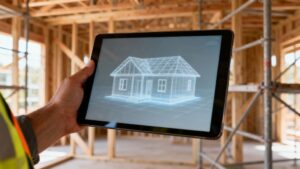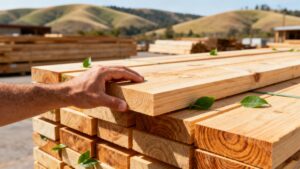For any contractor working in the Bay Area, time is money. Every minute on the job site counts, and fighting with warped boards or inconsistent sizing in traditional lumber throws the schedule—and the budget—out the window. It leads to callbacks, frustrating delays, and labor hours spent fixing problems that shouldn't exist.
That's exactly why so many professional builders are switching to engineered lumber. It delivers predictable performance that helps them build faster, straighter, and stronger, right from the get-go.
Why Modern Framing Demands Smarter Materials
In a competitive market like Berkeley or Oakland, framing crews can't afford to waste days culling lumber deliveries or shimming bowed studs. Traditional dimensional lumber, with its natural tendency to twist, cup, and warp, creates frustrating bottlenecks. This is where engineered lumber isn't just a different material—it's a strategic advantage for productivity.
Engineered wood products are created under intense heat and pressure, bonding wood strands and veneers with powerful adhesives. This manufacturing process eliminates the natural imperfections you find in sawn lumber. The result? Framing components that are exceptionally stable, perfectly uniform, and dead-on reliable every time.
The Power of Precision and Speed
The real benefits of engineered lumber become crystal clear when you're on the clock. It's all about efficiency.
The infographic below nails down how these materials help pros get the job done faster while achieving superior strength and straightness.
This kind of precision is a game-changer for Bay Area job sites. Think about it: with less than 1% dimensional variation compared to the 3–5% you often find in traditional lumber, crews can frame a typical home 10–15% faster. No more fighting the material—just faster, cleaner work.
But it’s not just about performance; it’s also about sustainability. The manufacturing process uses wood fiber more efficiently, creating incredibly strong structural components from smaller, faster-growing trees. Learn more in our guide to eco-friendly construction materials.
Traditional Lumber vs. Engineered Lumber at a Glance
To put it simply, here’s a quick breakdown of how these materials stack up on the job site. This isn't just about what's on the spec sheet; it's about what your crew experiences every day.
| Attribute | Traditional Dimensional Lumber | Engineered Lumber (LVL, I-Joists) |
|---|---|---|
| Consistency | Highly variable; requires culling and sorting for usable pieces. | Extremely consistent; virtually no variation between pieces. |
| Straightness | Prone to warping, twisting, and crowning. | Manufactured to be perfectly straight and stays that way. |
| Strength | Limited by natural wood defects like knots. | Higher strength-to-weight ratio; predictable load capacity. |
| Labor Impact | Requires extra time for shimming, planing, and correcting. | Reduces labor costs by minimizing adjustments and callbacks. |
| Span Capability | Shorter spans, often requiring more support columns. | Longer, clearer spans possible, allowing for open floor plans. |
| Waste | Higher waste factor due to unusable, culled pieces. | Minimal waste; every piece is usable. |
Ultimately, the consistency of engineered products offers a clear path to a more efficient, profitable, and higher-quality project.
Understanding Engineered Lumber
So, what’s the big deal with engineered lumber? How is it different from the stacks of dimensional lumber you see on every job site?
Think of it this way: traditional lumber is like a raw block of iron, while engineered lumber is a high-performance engine built from precision parts. One is simply cut from a log, flaws and all. The other is meticulously manufactured for consistent, predictable results every time.
The manufacturing process itself is impressive. Wood veneers, strands, or fibers are layered and bonded with industrial-strength adhesives under intense heat and pressure. This process “engineers out” the natural weak points you fight with in solid wood, like knots and twists.
Key Types of Engineered Lumber
Here at our Berkeley building materials yard, we stock the essential engineered products that framing crews depend on. Each product is designed for a specific job, and they work together to create a framing system that's stronger and more reliable than old-school methods.
- Laminated Veneer Lumber (LVL): Made from multiple layers of thin wood veneers, LVLs are absolute workhorses. They are exceptionally strong and have become the go-to for headers, beams, and girders, especially for the long, open spans in modern Bay Area home designs.
- I-Joists: Shaped like the letter "I," these have a vertical web of oriented strand board (OSB) with top and bottom flanges. This design creates an incredible strength-to-weight ratio, making them perfect for floor and roof joists that won't warp, twist, or squeak.
- Laminated Strand Lumber (LSL): LSL is made from wood strands bonded together. It’s a versatile product often used for headers, beams, wall studs, and rim board. It's another fantastic option for building straight, stable walls and floors that stay that way.
This manufacturing process gives engineered lumber a dimensional stability that traditional wood just can't match. It resists warping, shrinking, and swelling—a massive advantage in the Bay Area’s variable climate. That means preventing the drywall cracks and uneven floors that lead to frustrating, time-wasting callbacks.
Once you understand the basics of what engineered wood is, it’s easy to see why it helps contractors build better.
The Faster, Straighter, Stronger Advantage
For any busy contractor in the Bay Area, time is money. Engineered lumber has a direct impact on your bottom line by speeding up your workflow and cutting down on costly mistakes.
The secret is its reliability. The global engineered wood market keeps growing simply because pros trust its quality, as noted in this market analysis by Coherent Market Insights. Fewer adjustments on site and less wasted material—it's just a smarter way to build.
Build Faster, Spend Less on Labor
Labor is often the biggest variable on a project budget. Engineered lumber helps you control that cost by making the framing process incredibly efficient.
Unlike a pile of dimensional lumber, engineered products arrive at your site perfectly straight and uniform. Your crew spends zero time culling boards or wrestling with warped studs. All that time saved adds up fast, letting your team move on to the next phase ahead of schedule.
Build Straighter, Reduce Callbacks
In demanding markets like San Francisco and Berkeley, clients expect a flawless finish. But warped studs and uneven joists set you up for drywall cracks, sticky doors, and creaky floors—all things that lead to expensive callbacks.
Engineered lumber’s dimensional stability is your best defense against these issues. Its resistance to twisting, warping, and shrinking means walls stay plumb and floors stay flat. This consistency gives you a higher quality build and protects your hard-earned reputation.
By eliminating the inconsistencies found in natural wood, engineered lumber provides a predictable foundation for the rest of the build. Drywall goes up smoother, cabinets hang level, and trim fits tightly.
Build Stronger with Greater Design Freedom
Today's architecture is all about open-concept spaces and long, clean sightlines. Trying to achieve that with traditional lumber often means bulky beams or extra support columns that clutter the design.
Engineered lumber delivers a much higher strength-to-weight ratio, allowing for impressively long spans without sacrificing structural integrity. This opens up a world of design possibilities for architects and builders.
- Laminated Veneer Lumber (LVL) is the go-to for headers and beams, easily supporting heavy loads over wide doorways and windows.
- I-Joists provide incredible strength for floors and roofs but are lightweight, making them easier for your crew to handle and install.
- This strength makes it a great partner for other advanced systems. Learn more in our guide on what structural insulated panels are.
By embracing these modern materials, you can confidently deliver the wide-open, contemporary spaces your Bay Area clients want.
Choosing the Right Engineered Lumber for the Job
Picking the right engineered product for each part of the frame is key to unlocking its full potential. When you use these materials strategically, the structure gets stronger and the entire building process speeds up. That’s a huge deal when navigating tough building codes in Berkeley and Oakland.
Let's break down the three most common engineered wood products we see on job sites and where to use them.
Laminated Veneer Lumber for Beams and Headers
When it comes to carrying heavy loads over long distances, Laminated Veneer Lumber, or LVL, is the undisputed champion. It's made by bonding multiple thin layers of wood veneer together, creating a beam that is exceptionally strong, straight, and consistent.
You’ll see LVLs used in a few key spots:
- Headers: For wide openings—like garage doors or multi-panel patio doors—an LVL gives you the strength you need without the bulk.
- Beams: In open-concept floor plans, LVLs are perfect for the main support beams that carry floor joists.
- Ridge Beams: For dramatic vaulted ceilings, LVLs offer the structural integrity required to support the roof's weight across long spans.
Because LVLs are manufactured, their load-carrying capacity is predictable and reliable—essential for meeting seismic requirements in the Bay Area.
I-Joists for Floors and Roofs
I-joists are true engineering marvels, designed for maximum strength with minimum material. Their unique "I" shape—with a vertical OSB web and solid or LVL flanges—makes them incredibly efficient at handling loads for floors and roofs.
Builders are turning to I-joists because their strength-to-weight ratio allows for longer spans, and their dimensional stability eliminates the warping that leads to squeaky floors and costly callbacks.
I-joists are significantly lighter than dimensional lumber joists of the same depth. This makes them easier and safer for crews to handle and install, which can lead to a noticeable drop in labor time.
If you want to budget for your next floor system, check out our guide on the cost of TJI joists.
Rim Board to Complete the System
While LVLs and I-joists do the heavy lifting, rim board is the essential piece that ties the system together. It's an engineered wood product designed to fill the space between joists at the perimeter of the floor or roof.
It has a few critical jobs:
- Load Transfer: It channels vertical loads from the wall above down through the floor system.
- Lateral Support: It provides bracing to the ends of the I-joists, preventing them from twisting under load.
- Closing the System: It encloses the floor cavity, creating a flat surface for attaching sheathing and siding.
Using the right rim board ensures the entire framing package works as one integrated system.
Get Expert Support for Your Framing Package
Deciding to build with engineered lumber is a great call. But unlocking its true potential means more than just swapping out 2x10s for I-joists. The real magic happens when you have a precise plan, and that’s where getting the right support makes all the difference.
Getting the right advice upfront saves you from costly over-ordering, avoids job site delays, and helps your project sail through inspections the first time.
More Than Just Lumber—It’s a Partnership
A smooth framing job starts long before the first piece of lumber lands on your Berkeley or Oakland job site. It begins with solid planning and accurate calculations.
Here's what our expert support looks like:
- Professional Takeoffs: We review your blueprints to create a detailed materials list. This ensures you get exactly what you need, saving you from wasting money or making last-minute runs to the lumberyard.
- Accurate Sizing Calculations: Sizing LVL beams and I-joists requires careful calculations to handle specific loads. Our team does this for you, guaranteeing your structure is rock-solid and compliant with local Bay Area building codes.
- Detailed Layout Assistance: We can provide clear layouts that show your crew exactly how the framing system fits together. This eliminates confusion, speeds up installation, and cuts down the risk of mistakes.
Partnering with a supplier who brings this level of expertise means you're not just buying materials. You're investing in a smoother, more predictable building process from start to finish.
This commitment to expert guidance is a core part of how we do business. You can learn more about why Truitt & White is the best choice for contractor supplies in the Bay Area.
Your Questions About Engineered Lumber, Answered
Making the jump to new materials always brings up a few questions. To help you build with confidence, we’ve put together answers to some of the most common things we hear from Bay Area builders.
Isn't engineered lumber more expensive than traditional lumber?
While you might see a higher price per piece, engineered lumber often saves money on the total project budget. Its consistency means you aren’t paying for culled, unusable boards. More importantly, it reduces the labor hours spent fighting crooked framing, which is where real cost savings kick in.
Can I cut or drill into engineered lumber on the job site?
Absolutely, but you have to follow the manufacturer's specifications. For instance, I-joists have specific knock-out areas on the web where you can drill for utilities without compromising strength. Always have the product guide handy or ask our team at Truitt & White to avoid damaging its structural integrity.
How does engineered lumber handle the Bay Area climate?
It’s an excellent choice for our coastal climate. Engineered lumber is manufactured to be incredibly stable, so it’s far less prone to the moisture-related swelling and shrinking that plagues traditional wood. This stability means floors stay flat and walls remain straight over time, cutting down on callbacks.
Is engineered lumber a sustainable building material?
Yes, it's often considered a sustainable option. The manufacturing process is designed for exceptional efficiency, often using fast-growing, underused tree species and wood scraps that would otherwise be discarded. This smart approach creates more usable material from every log, which reduces waste.
Where can I get help sizing an LVL beam for my project?
Right here at Truitt & White. Our expert team in Berkeley is here to help you get it right the first time. We can review your plans and run the necessary calculations to ensure you get the correctly sized LVL beams, I-joists, and rim board for your specific load requirements.
Ready to Frame a Better Project?
Making the move to engineered lumber isn't just a material swap; it's an investment in your project's quality and your crew's efficiency. When you choose materials that let you build faster, straighter, and stronger, you eliminate frustrating and expensive callbacks that eat into your profits.
For builders, architects, and remodelers in the Bay Area, it all comes down to spending less time fighting warped boards and more time pushing the job forward. A superior framing package is one of the smartest calls you can make to protect your schedule and budget.
When your framing is precise, every trade that follows—from drywall to finish carpentry—can work more efficiently. It’s a ripple effect that saves time and money all the way to project completion, making engineered lumber a strategic choice for any serious pro.
Ready to see the difference on your next build? Let our team help you put together the perfect engineered lumber package.
Truitt & White has been the Bay Area pro’s choice for smarter building since 1946. Give our team a call for expert advice, takeoffs, and a quote on your next framing package. Visit our Berkeley showroom or get in touch today!








